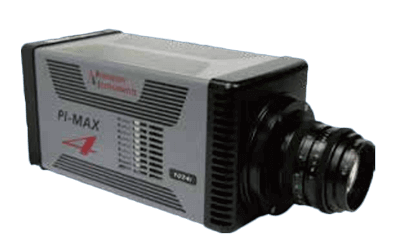What Are EMCCD Cameras?

EMCCD Cameras are CCD cameras that are capable of detecting faint light using an Electron Multiplying CCD element.
When detecting light with a normal CCD camera, a certain amount of bright light is required. When light is converted into an electrical signal, a certain amount of noise (unwanted information other than light) is added.
Even if faint light is converted into an electrical signal, it is buried in the noise and does not produce an image of sufficient intensity. EMCCD Cameras are able to detect faint light because the CCD sensor has an electronic doubling function when detecting light and converting it into an electrical signal.
Applications of EMCCD Cameras
The main applications for EMCCD Cameras are microscopes and telescopes. The observation area in a microscope is very narrow, and the brightness of the observation area is enhanced by an aperture and a reflector, but the amount of light is insufficient when captured by an ordinary CCD camera.
Therefore, the electrical signals converted from light are buried in noise.
On the other hand, EMCCD Cameras can convert and amplify faint light into electrical signals of sufficient intensity.
EMCCD Cameras are also used to compensate for the low light intensity when photographing faint celestial objects through a telescope.
Principle of EMCCD Cameras
1. CCD Sensor Mechanism
A CCD is a Charge-Coupled Device that converts light into electrical signals. While silver halide film is used in the light receiving part of conventional silver halide cameras (cameras that use film), CCD sensors are used in the light receiving part of many digital cameras.
A CCD sensor consists of small elements (photodiodes) called pixels. The photodiode converts light into an electric charge, and the CCD sensor outputs the charge as an electric current to produce an image.
2. Mechanism of EMCCD
The electrical signals are affected by noise when the electric current is applied, and therefore, with weak light, the electrical signals are buried in the noise and an appropriate image cannot be obtained. Therefore, the EMCCD sensor doubles the electric charge converted from light to a level unaffected by noise.
By doubling the charge, the electrical signal is also doubled, so the output image is sharper and clearer. In this way, EMCCD Cameras can be used in microscopes, telescopes, and other applications that require the detection of faint light to obtain images with sufficient shading to be of practical use.
Structure of EMCCD Cameras
1. CCD Sensor Part
Potential wells are created by applying different voltages to electrodes on the surface of the silicon substrate of the CCD sensor. When light is received by the CCD sensor unit, a charge is generated due to the photoelectric effect.
After the charge is captured in the potential well, it is digitized by an AC converter in a normal CCD. On the other hand, in an EMCCD, the charge is transported to the gain register for charge doubling before digitization.
2. Gain Register
The gain register is a mechanism that doubles the charge sent from the CCD sensor section. It makes use of the phenomenon (impact ionization phenomenon) in which a high electric field is applied during electron transfer to create a new electron-hole pair in a high-energy state.
Other Information on EMCCD Cameras
Noise Factors
EMCCD noise is classified into the following four categories, each of which requires countermeasures:
1. Fixed Pattern Noise
This is noise resulting from variations in the sensitivity of each pixel in the CCD sensor.
2. Shot Noise
This is noise that depends on the number of photons incident on the CCD sensor. As the number of photons increases, shot noise also increases.
3. Dark Shot Noise
The current generated in the CCD sensor in the absence of photon input is called dark current. Dark shot noise is noise caused by dark current, and dark shot can be reduced by reducing dark current.
4. Readout Noise
Readout noise is a noise that originates from the hardware that makes up the camera, including the CCD sensor.